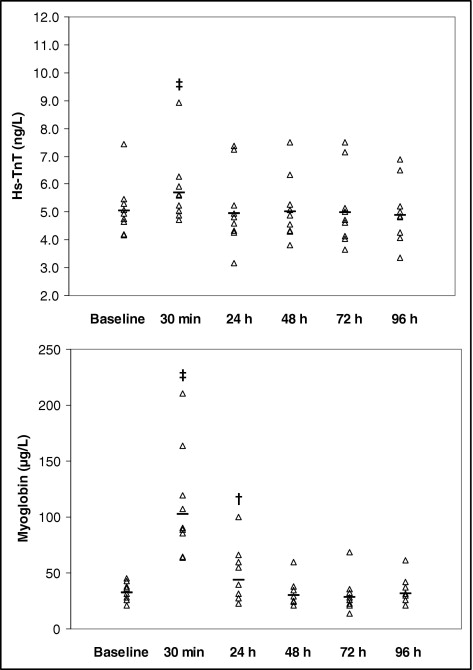Mousavi et al recently reported that immediately after the completion of a full marathon, all athletes demonstrated elevated cardiac troponin T (cTnT) levels, with a median value of 0.31 μg/L, greater than the 99% reference limit. This increase in cTnT was attributed to cytosolic release of the biomarker, not to the true breakdown of the myocyte. Similar results were also reported by Mingels et al, who observed that 86% of marathon runners had cTnT concentrations greater than the 99th percentile as measured by a novel highly sensitive cTnT (Hs-TnT) assay. Interestingly, Giannitsis et al found several patterns of Hs-TnT concentration changes during a continuous 216-km marathon, including cases with constantly low concentrations without changes as well as cases with early increases of Hs-TnT after the start of strenuous exercise. Koller and Schobersberger hypothesized, however, neither that the increase in cardiac troponin after marathon running is likely due to the cytosolic release of the biomarker nor that the release of cardiac troponin represents the true breakdown of the myocytes. Therefore, to further assess whether skeletal muscular damage rather than myocardial injury might contribute to the increased cardiac troponin levels after physical exercise, we assessed the influence of eccentric exercise on the levels of the novel Hs-TnT.
Nine healthy men performed a 40-minute downhill protocol on a treadmill with a gradient of −25% and a walking velocity of 6.4 km/hour. To increase the likelihood that the downhill protocol would induce muscle damage, subjects were loaded with 10% of their body weight, carried in a back pack, according to the standard protocol of Ahmadi et al. Blood samples were drawn before exercise and 30 minutes and 24, 48, 72, and 96 hours thereafter. Serum cTnT was measured with the new Hs-TnT (Roche Diagnostics GmbH, Mannheim, Germany) on the Modular System P automated analyzer (Roche Diagnostics GmbH), which uses chemiluminescence technology. As previously reported, the interassay coefficients of variation of this assay are 8% at 10 ng/L and 2.5% at 100 ng/L, and the intra-assay coefficients of variation are 5% at 10 ng/L and 1% at 100 ng/L. The diagnostic range of this assay is 2 to 10,000 ng/L. As shown in Figure 1 , significant increases of Hs-TnT and myoglobin levels were recorded immediately after the exercise (p <0.001 for both). Myoglobin values remained significantly elevated for 24 hours thereafter (p = 0.017). In no case, however, did the values of Hs-TnT exceed the 99th percentile for apparently healthy subjects throughout the study period (16 ng/L). Forty-eight hours after the exercise, Hs-TnT and myoglobin had returned to values nonsignificantly different from baseline.





